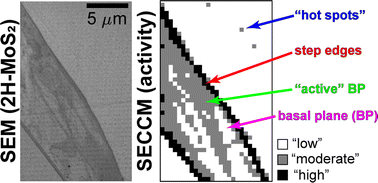Direct electrochemical identification of rare microscopic catalytic active sites†
Abstract
Local voltammetric analysis with a scanning electrochemical droplet cell technique, in combination with a new data processing protocol (termed data binning and trinisation), is used to directly identify previously unseen regions of elevated electrocatalytic activity on the basal plane (BP) of molybdenum disulfide (2H-MoS2). This includes BP-like structures with hydrogen evolution reaction activities approaching that of the edge plane and rare nanoscale electrocatalytic “hot-spots” present at an areal density of approximately 0.2–1 μm−2. Understanding the nature of (sub)microscopic catalytic active sites, such as those identified herein, is crucial to guide the rational design of next-generation earth-abundant materials for renewable fuels production.

- This article is part of the themed collection: ChemComm Milestones – First Independent Articles


 Please wait while we load your content...
Please wait while we load your content...